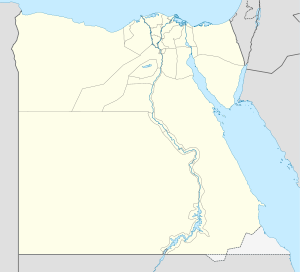- Damanhur
-
This article is about the Egyptian city. For the Italian community, see Federation of Damanhur.
Damanhur
دمنهورLocation in Egypt Coordinates: 31°03′N 30°28′E / 31.05°N 30.467°E Country  Egypt
EgyptGovernorate Beheira Population (2011) - Total 242,700 Time zone EST (UTC+2) Damanhur (Arabic: دمنهور Damanhūr, Egyptian: Dmỉ-n-Ḥr.w, Coptic: Ⲧⲙⲉⲛϩⲱⲣ, Greek: Ἑρμοῦ πόλις μικρά Hermopolis Mikra) is a city in Lower Egypt, and the capital of the Beheira Governorate. It is located 160 km (99 mi) northwest of Cairo, and 70 km (43 mi) E.S.E. of Alexandria, in the middle of the western Nile Delta.
In Ancient Egypt, the city was the capital of Lower Egypt's 7th Nome of A-ment. It stood on the banks of a canal which connected the lake Mareotis with the Canopic or most westerly arm of the Nile. (Champollion, L'Egypte, vol. ii. p. 249). The city was dedicated to the Ancient Egyptian god Horus. In Greek and Roman times, it was called Hermopolis Mikra or Hermopolis Parva, which would also give it an association with Hermes, the Egyptian Thoth. As Hermopolis, the city attracted the notice of numerous ancient geographers, including Stephanus of Byzantium s. v., Strabo (xvii. p. 802), Ptolemy (iv. 5. § 46), and the author of the Antonine Itinerary (p. 154). It is a Roman Catholic titular see.
In 1986, the population of Damanhur was 188,939. The richly-cultivated Beheira province gives rise to mainly agricultural industries which include cotton ginning, potato processing, and date picking. It also has a market for cotton and rice.
Ahmed H. Zewail, who won the Nobel Prize for Chemistry in 1999, was born in Damanhur in 1946.
Contents
Etymology
Damanhur (or Damanhour) was known in the ancient Egyptian scripts by the name "Di Men Hor", which means the city of god Hor or Horus, on the grounds that it was a center for the worship of this god. It was also known by other names: in the Egyptian texts also known as "Behdet", in the Greek texts known as the "Hermopolis Prva" which means the city Hermes Minor, also called "Obollenoboles" in regards to the Greek god Apollo, and then they called it "Tel Ballamon". Later, the Egyptians returned the original old name, and pronounse it "Temenhor", and after the Islamic conquest they misrepresented the name to its name in Arabic which is now known as "Damanhur".
Climate
Being located close to the Nile Delta that gives Damanhur a Mediterranean climate. The city gets average precipitation during winter, and rare rain during other seasons. Hail and frost are not unknown specifically during winter.
Tomb of Yaakov Abuhatzeira
The town contains the tomb of Yaakov Abuhatzeira (1805–1880) a Moroccan Rabbi who died here in 1880 while on a pilgrimage to the Land of Israel. The site is visited each year by hundreds of devotees.[1] The tomb is an official antiquity site protected by the government of Egypt.[2] Some Egyptians have protested against permitting Jews to enter Egypt to make the annual pilgrimage to Rabbi Abuhatzeira's tomb.[3][4]
Cultural references
Damanhur is the fictional home of the character Nebamon in the book Rise of the Golden Cobra, by Henry T. Aubin.
Damanhur name is used by the artist eco-village in northern Italy.
References
- ^ Barak, David. Mubarak to allow Jewish pilgrims to visit famous rabbi's tomb, Haaretz, (December 30, 2009).
- ^ Lipton, Edward P. (2002). Religious Freedom in the Near East, Northern Africa and the Former Soviet States. New York: Nova Publishers. p. 18. ISBN 9781590333907. http://books.google.com/books?id=43_j4vdkk5MC&pg=PA18. Retrieved 2011-02-16.
- ^ Miller, David E. (28 December 2010). "Israeli pilgrims to Egyptian grave met with hostility" (Reprint). The Media Line. http://www.allheadlinenews.com/briefs/articles/90028915?Israeli%20pilgrims%20to%20Egyptian%20grave%20met%20with%20hostility. Retrieved 2011-02-16.
- ^ "Cairo Airport prepares for Israeli pilgrims". Al-Ahram. 26 December 2010. http://english.ahram.org.eg/NewsContent/1/0/2674/Egypt/Cairo-Airport-prepares-for-Israeli-pilgrims-.aspx. Retrieved 2011-02-16.
 This article incorporates text from a publication now in the public domain: Chisholm, Hugh, ed (1911). Encyclopædia Britannica (11th ed.). Cambridge University Press.
This article incorporates text from a publication now in the public domain: Chisholm, Hugh, ed (1911). Encyclopædia Britannica (11th ed.). Cambridge University Press. This article incorporates text from a publication now in the public domain: Smith, William, ed (1854–57). "article name needed". Dictionary of Greek and Roman Geography. London: John Murray.
This article incorporates text from a publication now in the public domain: Smith, William, ed (1854–57). "article name needed". Dictionary of Greek and Roman Geography. London: John Murray.
External links
- Falling Rain Genomics, Inc. "Geographical information on Damanhur, Egypt". http://www.fallingrain.com/world/EG/3/Damanhur.html. Retrieved 2008-03-30.
- http://www.damanhour.5u.com Arabic script
- http://www.damanhour.5u.com/en.htm English script
- http://www.saeednet.4t.com live cam from damanhour
- "Hermopolis Parva". Catholic Encyclopedia. New York: Robert Appleton Company. 1913. http://www.newadvent.org/cathen/07289b.htm.
Coordinates: 31°03′N 30°28′E / 31.05°N 30.467°E
 Egypt's Largest cities by population
Egypt's Largest cities by populationGovernorates capitals of Egypt Governorate (capital) Alexandria (Alexandria) · Aswan (Aswan) · Asyut (Asyut) · Beheira (Damanhur) · Beni Suef (Beni Suef) · Cairo (Cairo) · Dakahlia (Mansoura) · Damietta (Damietta) · Faiyum (Faiyum) · Gharbia (Tanta) · Giza (Giza) · Ismailia (Ismailia) · Kafr el-Sheikh (Kafr el-Sheikh) · Luxor (Luxor) · Matrouh (Mersa Matrouh) · Minya (Minya) · New Valley (Kharga) · North Sinai (Arish) · Qalyubia (Benha) · Qena (Qena) · Red Sea (Hurghada) · Sharqia (Zagazig) · Sohag (Sohag) · South Sinai (El-Tor) · Suez (Suez)
Categories:- Governorate capitals in Egypt
- Nile River Delta
- Ancient Greek sites in Egypt
- Populated places in the Beheira Governorate
- Roman sites in Egypt
- Titular sees in Africa
- Jewish pilgrimage sites
Wikimedia Foundation. 2010.


